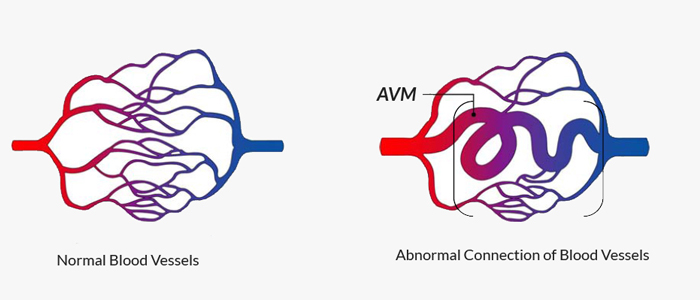
Arteriovenous Malformation (AVM)
Arteriovenous malformations (AVMs) are a vascular mass that consist of tangled blood vessels of varying sizes in which there is one or more direct connections between the arterial and venous circulations.

Arteries are thick-walled tubes that carry high pressure blood being pumped from the heart to the brain and other organs, whereas veins are thin-walled tubes that carry low pressure blood passively draining its way back to the heart. This direct connection from high pressure arterial blood flow to thin walled veins, which do not normally get exposed to high pressure blood flow, increases the risk of rupturing and resulting in bleeding into the brain. These abnormal blood flow patterns can cause problems to develop in the arteries leading to the AVM, including the formation of aneurysms.
AVMs are usually asymptomatic prior to rupture and are detected during other procedures. If a brain AVM or AVM-associated aneurysm ruptures, brain damage or death may result depending on the severity of the hemorrhage. Symptoms of a ruptured brain AVM often come on suddenly and include a sudden, severe headache (“worst headache of my life”) that is different from past headaches, nausea and vomiting, sensitivity to light, weakness, confusion, fainting or loss of consciousness, and seizures.
AVMs can damage the brain and spinal cord by reducing the amount of oxygen reaching neurological tissues, bleeding into surrounding tissue (hemorrhage) that can cause stroke or brain damage, and by compressing or displacing parts of the brain or spinal cord.
Treatment
Treatment options depend on the type of AVM, its location, noticeable symptoms, and the general health condition of the individual. Medication can often alleviate general symptoms such as headache, back pain, and seizures caused by AVMs and other vascular lesions. The definitive treatment for AVMs is either surgery to either remove the AVM or to create an artificial blood clot to close the lesion or focused irradiation treatment that is designed to damage the blood vessel walls and close the lesion. The decision to treat an AVM requires a careful consideration of possible benefits versus risks.
Prognosis
The greatest potential danger posed by AVMs is hemorrhage. Most episodes of bleeding remain undetected at the time they occur because they are not severe enough to cause significant neurological damage. But massive, even fatal, bleeding episodes do occur. Whenever an AVM is detected, the individual should be carefully and consistently monitored for any signs of instability that may indicate an increased risk of hemorrhage. Individuals who are treated require brain imaging afterwards to evaluate if the AVM has been completely removed or destroyed. The risk of hemorrhage remains if some of the AVM persists despite treatment.
Contact Us
The Pacific Stroke and Neurovascular Center’s state-of-the-art facilities are located at:
Providence Saint John’s Health Center
2125 Arizona Ave., Santa Monica, CA 90404
310-829-8319
Providence Little Company of Mary Medical Center Torrance
4201 Torrance Blvd., Suite 520, Torrance, CA 90503
424-212-5340
Providence Saint Joseph Medical Center
501 S. Buena Vista Ave., Burbank, CA 90505
818-847-6049
Providence Holy Cross Medical Center
15031 Rinaldi St, Mission Hills, CA 91345
818-847-6570